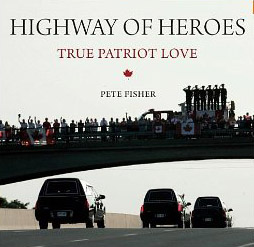
It was a Saturday in the spring of 2002. A photographer, who been born and raised and in fact had worked most of his professional life for newspapers in and around Cobourg, Ont., got a call from his father. Pete Fisher’s dad told him to keep an eye out for something happening on Highway 401. Four Canadian soldiers’ bodies had just arrived home from Afghanistan and it looked as if there would be a procession along the highway between CFB Trenton and Toronto, where the bodies would officially be released to the families.
“I didn’t know the soldiers’ names,” Fisher wrote later.
They were Ainsworth Dyer, Richard Green, Marc Leger and Nathan Smith – the first four Canadian troops killed in the War in Afghanistan (ironically killed by a U.S. pilot who thought his jet fighter was under attack by Taliban or Al-Qaeda fire).
Though Fisher didn’t know these young servicemen, their deaths and repatriation to Canada were about to change his career and in many ways his country. In his just published book, “Highway of Heroes,” Fisher explained his first instinct wasn’t to rush to the 401 and take pictures. No, Fisher’s reflex action was to call Cobourg’s emergency services dispatcher.
“I mentioned to Bob (Jenkins) that it might be nice to have a show of support from the local police on the bridges,” Fisher said.
Almost instantly, word spread from Trenton to Cobourg to Port Hope and west toward Toronto, that a military funeral procession was en route and it could use an appropriate send-off. Firefighters, paramedics, police, former peacekeepers and other veterans who’d heard by the grapevine that military hearses were coming their way, began assembling impromptu by the roadside and on the overpasses along the 401.
Only then, did Fisher pick up his camera and capture the first of thousands of images that would ultimately appear in his current Dundurn book.
“I couldn’t have imagined the great outpouring of support that would follow,” Fisher wrote, “(nor) the sheer number of people who would come out … to stand along this remarkable stretch of highway.”
The past decade has changed the way a lot of Canadians view their military. Whether the soldier involved was a family member or the friend of a family member, and whether Canadians supported the operations in Afghanistan or not, public sentiment has become more vocal and visible since this nation’s forces entered that war in 2002.
They’ve seen video nightly of Canadian troops in fire fights with so-called insurgents. They’ve seen Canadian Forces generals interviewed about battle strategy. And since – for the first time in Canadian history – Canadian troops were not being buried where they fell, but brought home, Canadian civilians have experienced the military’s losses – now 158 of them – up close and personal.
Indeed, perhaps the most vivid military images in Canadians’ faces since the Afghanistan war began, have come from the camera of Cobourg-based photojournalist Pete Fisher. They’ve shown mourners known and unknown, official and not, adult and the very young, flag wavers and those standing sentinel still, in blistering sun or penetrating winter wind, there as the processions passed.
Fisher has captured national sentiment these past 10 years. He’s documented a nation’s coming out, if you like, coming out of its ambivalence about military involvement, military role and military cost. He’s shown Canadians a lot of their sadness, a little of their soul.
Not only was Pete Fisher responsible for this sentiment and the images of “Highway of Heroes,” his book was also in part responsible for the name itself. The phrase was coined by Toronto Sun columnist Joe Warmington, in June 2007. When the newspaper ran his column using the words, it published one of Fisher’s bridge photographs on the front page. From their column and photograph to the government’s ears. On Sept. 17, 2007, Ontario officially designated the repatriation route from Trenton to Toronto as “the Highway of Heroes.”
Pete Fisher and I met a few years ago – at least in correspondence and over the phone – when I approached him about publishing one of his highway shots in one of my books. He didn’t hesitate a second. And a shot showing grieving a family waving their hands out the windows of a funeral procession limousine to bystanders on a bridge, accented my telling of the friendly fire incident of 2002.
When I spoke to Fisher recently, he admitted he’d felt overcome as his book hit the stands. At his book launch, in addition to the publishing and military dignitaries, he said a number of fallen soldiers’ families attended.
“I’m not used to being on this side of the microphone,” he said. He thanked all those who’d come to the event and lamented, “This was a book I wish never had to be written.”